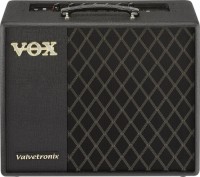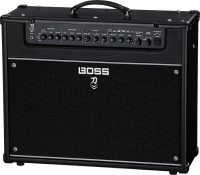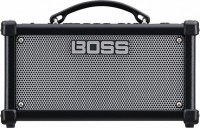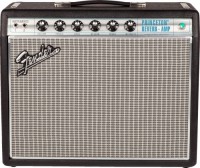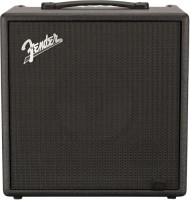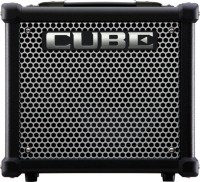Guitar Amps & Cabs VOX
All models Advanced filters → |
You might be interested in
Guitar Amps & Cabs: specifications, types
Show all
Device type
General device type.
Nowadays, on the market you can find both ready combo amplifiers, and separate components for them — cabinets(including active and amplifiers (heads). Here is a description of each of these varieties.
— Combo amplifier. Combined guitar amplifiers in the traditional sense of the word. Externally, such a device is usual...ly a characteristic box with a built-in speaker, inputs for connecting a guitar (often several guitars) and other signal sources, controls for adjusting the sound, and in most cases also handles or other devices for easy carrying. Inside are a speaker, two amplifiers (pre-amp and power), as well as electronic circuits designed primarily to process the incoming signal from the instrument's pickups. Thus, a combo amp includes everything you need to provide the full sound of a guitar of one type or another (see "Intended Use"). The set of settings, effects (see below) and other special features in such devices can be different — from the simplest to the most extensive. The same goes for power: small “amps” are designed mainly for home use, more powerful ones can be used at rehearsal facilities and concerts in relatively simple conditions — for example, in a pub, club or right on the street. Well, anyway, it is the combo amplifier that will be the best option for a novice guitarist who is just mastering the instrument and equipment. But for large mass events, not combo amplifiers are better suited, but the so-called stacks — systems from a separately selected cabinet and head (see below for both).
— Cabinet. A cabinet is a separately made specialized speaker (speaker in a cabinet), designed primarily for use with a guitar amplifier (usually a separate “head” — see below). The cabinets do not have their own inputs for the instrument (with a few exceptions — and in such cases the speaker is used only to switch the signal to an external amplifier), power amplifiers — too, so such equipment is not designed for independent use in principle. And from more traditional acoustics, such speakers differ in additional optimization specifically for the sound of a guitar / bass (depending on the purpose). At the same time, the cabinet can have several inputs (see "Connection") and be used for several instruments at once — for example, solo and rhythm guitar at the same time.
Note that most cabinets have a fairly high power — from 100 W and above — and are intended mainly for concert use as part of a "stack" (a system of one or more speakers and a "head" amplifier installed on it).
— Active office. A rather rare and specific type of cabinets described above are guitar speakers, supplemented by built-in power amplifiers (and sometimes preamps). In fact, they are a simplified version of combo amplifiers — with a minimum set of adjustments (or even without them at all), but having at least the ability to work with line-level sound coming from the preamplifier to the line input, and in some models — also the possibility of direct connection guitars to the instrumental input. At the same time, most active cabinets have fairly powerful built-in acoustics (200 W or more), and sometimes also the ability to connect additional passive speakers. Such devices are mainly used as concert equipment; among other things, by connecting an active cabinet to the main “amp” or “head”, you can noticeably unload the main guitar power amplifier and achieve high volume without significant loads on the equipment.
Another, even more specific type of active cabinets are compact speakers designed to work with guitar amplifiers, which were originally designed exclusively for outputting sound to headphones. The level of the signal given out by such a device to the "ears" is comparable to the level of a linear signal; accordingly, additional amplification is required for playback through the speaker — which is provided by the hardware of the active cabinet.
— Amplifier (head). Separately made guitar amplifiers, not equipped with built-in acoustics. Traditionally, such devices are used in the "stack" format — in combination with a cabinet (see above) or a pair of cabinets; in this case, the amplifier is usually placed directly on the speaker (a "stack" of speakers), hence the slang name "head". If desired, other types of acoustics can be connected to the amplifier, however, cabinets remain the main purpose anyway. In general, a separate “head” in some situations is a more justified option than a solid combo amplifier. So, one of the main advantages of such devices is that you can choose speakers for them at your discretion; and if you already have a cabinet or other suitable acoustics, buying a “head” allows you not to overpay for extra equipment. The second advantage is that many stand-alone amplifiers are very advanced, with a wide range of features and/or high output power. In combination with the freedom of choice of acoustics mentioned above, this makes such equipment an perfect option for professional use (primarily for concerts). However, fairly simple and inexpensive “heads” are also produced, designed for beginner musicians and amateurs.
Nowadays, on the market you can find both ready combo amplifiers, and separate components for them — cabinets(including active and amplifiers (heads). Here is a description of each of these varieties.
— Combo amplifier. Combined guitar amplifiers in the traditional sense of the word. Externally, such a device is usual...ly a characteristic box with a built-in speaker, inputs for connecting a guitar (often several guitars) and other signal sources, controls for adjusting the sound, and in most cases also handles or other devices for easy carrying. Inside are a speaker, two amplifiers (pre-amp and power), as well as electronic circuits designed primarily to process the incoming signal from the instrument's pickups. Thus, a combo amp includes everything you need to provide the full sound of a guitar of one type or another (see "Intended Use"). The set of settings, effects (see below) and other special features in such devices can be different — from the simplest to the most extensive. The same goes for power: small “amps” are designed mainly for home use, more powerful ones can be used at rehearsal facilities and concerts in relatively simple conditions — for example, in a pub, club or right on the street. Well, anyway, it is the combo amplifier that will be the best option for a novice guitarist who is just mastering the instrument and equipment. But for large mass events, not combo amplifiers are better suited, but the so-called stacks — systems from a separately selected cabinet and head (see below for both).
— Cabinet. A cabinet is a separately made specialized speaker (speaker in a cabinet), designed primarily for use with a guitar amplifier (usually a separate “head” — see below). The cabinets do not have their own inputs for the instrument (with a few exceptions — and in such cases the speaker is used only to switch the signal to an external amplifier), power amplifiers — too, so such equipment is not designed for independent use in principle. And from more traditional acoustics, such speakers differ in additional optimization specifically for the sound of a guitar / bass (depending on the purpose). At the same time, the cabinet can have several inputs (see "Connection") and be used for several instruments at once — for example, solo and rhythm guitar at the same time.
Note that most cabinets have a fairly high power — from 100 W and above — and are intended mainly for concert use as part of a "stack" (a system of one or more speakers and a "head" amplifier installed on it).
— Active office. A rather rare and specific type of cabinets described above are guitar speakers, supplemented by built-in power amplifiers (and sometimes preamps). In fact, they are a simplified version of combo amplifiers — with a minimum set of adjustments (or even without them at all), but having at least the ability to work with line-level sound coming from the preamplifier to the line input, and in some models — also the possibility of direct connection guitars to the instrumental input. At the same time, most active cabinets have fairly powerful built-in acoustics (200 W or more), and sometimes also the ability to connect additional passive speakers. Such devices are mainly used as concert equipment; among other things, by connecting an active cabinet to the main “amp” or “head”, you can noticeably unload the main guitar power amplifier and achieve high volume without significant loads on the equipment.
Another, even more specific type of active cabinets are compact speakers designed to work with guitar amplifiers, which were originally designed exclusively for outputting sound to headphones. The level of the signal given out by such a device to the "ears" is comparable to the level of a linear signal; accordingly, additional amplification is required for playback through the speaker — which is provided by the hardware of the active cabinet.
— Amplifier (head). Separately made guitar amplifiers, not equipped with built-in acoustics. Traditionally, such devices are used in the "stack" format — in combination with a cabinet (see above) or a pair of cabinets; in this case, the amplifier is usually placed directly on the speaker (a "stack" of speakers), hence the slang name "head". If desired, other types of acoustics can be connected to the amplifier, however, cabinets remain the main purpose anyway. In general, a separate “head” in some situations is a more justified option than a solid combo amplifier. So, one of the main advantages of such devices is that you can choose speakers for them at your discretion; and if you already have a cabinet or other suitable acoustics, buying a “head” allows you not to overpay for extra equipment. The second advantage is that many stand-alone amplifiers are very advanced, with a wide range of features and/or high output power. In combination with the freedom of choice of acoustics mentioned above, this makes such equipment an perfect option for professional use (primarily for concerts). However, fairly simple and inexpensive “heads” are also produced, designed for beginner musicians and amateurs.
Features
The instrument for which the amplifier is intended.
In general, the meaning of this paragraph is quite obvious, we note only a few nuances. So, it hardly makes sense to use an “amp” for an acoustic guitar with an electric guitar, and vice versa — these are two fundamentally different instruments with different initial sound characteristics. In addition, combo amps for electric guitars are quite often equipped with a set of additional effects, includin...g distortion or overdrive (see "Effects"), although there are many models without such functions. But in devices for “acoustics”, although effects are also found, they are not so “radical” and are intended mainly for easy sound processing, and not for its fundamental distortion. In bass amplifiers, in turn, it may be possible to connect an active electric guitar and work two instruments at once through one “amp”.
In general, the meaning of this paragraph is quite obvious, we note only a few nuances. So, it hardly makes sense to use an “amp” for an acoustic guitar with an electric guitar, and vice versa — these are two fundamentally different instruments with different initial sound characteristics. In addition, combo amps for electric guitars are quite often equipped with a set of additional effects, includin...g distortion or overdrive (see "Effects"), although there are many models without such functions. But in devices for “acoustics”, although effects are also found, they are not so “radical” and are intended mainly for easy sound processing, and not for its fundamental distortion. In bass amplifiers, in turn, it may be possible to connect an active electric guitar and work two instruments at once through one “amp”.
Type
The type of device is determined by the element base — the main type of parts on which the power amplifier circuits are built. Accordingly, this parameter is relevant only for equipment with such amplifiers; for cabinets (see "Type") it is not indicated.
The most popular nowadays continue to use traditional types of amplifiers — transistor and tube. Digital models are noticeably l...ess popular, and hybrid solutions are rare at all. Here is a detailed description of each of these options:
— Transistor. Amplifiers of this type are relatively simple and inexpensive, while being able to provide quite acceptable sound quality (although, of course, everything depends on the class). It is the “transitor” that is recommended for beginner guitarists as the first “combo”, although there are quite advanced models among such devices. Of the unequivocal advantages of transistor circuits, one can name the durability of the components and the ability to easily transfer frequent carrying from place to place. As for the sound, in such devices it turns out to be more “dry”, “flat” and “cold” than in tube models, which many consider to be a clear disadvantage. At the same time, in the case of electric guitars, even this is quite enough for initial training, rehearsals and not very “fancy” performances; in addition, some transistor amplifiers use specific signal processing to give the sound a tube-like sound. And combo amplifiers for acoustic guitars are overwhelmingly made with transistors.
— Lamp. Historically, the first type of amplifier, which, nevertheless, is still considered almost the standard when it comes to electric guitar (tube circuits are practically not used for acoustic guitars). The main advantage of such devices is the notorious “warm tube sound”, a characteristic soft, warm and at the same time rich coloring of the sound. At the same time, we note that the level of distortion in tube circuits is higher than in transistor circuits, however, these distortions are more pleasant to the ear, in many respects they provide the mentioned coloring. The widespread use of tube amplifiers is hindered primarily by their high cost — several times higher than that of transistor amplifiers with similar characteristics. In addition, among the disadvantages of such devices, it is worth noting the delicacy (the lamps do not tolerate shocks and shocks), the rapid wear of the lamps and the need for their regular replacement, as well as the need for warming up after switching on. However, professional musicians prefer to use mainly tube devices.
— Digital. Chip-based amplifiers using digital audio processing. The main advantage of such devices is the extensive possibilities for modeling sound and providing various effects. In particular, there are many models that copy tube amplifiers: the imitation is very reliable, and sometimes almost indistinguishable from the original. At the same time, digital models are devoid of many of the shortcomings of lamp technology: they are simpler, cheaper, more durable and more resistant to shock and shock. At the same time, digital processing is considered to take away personality from the sound, and many high-end audio enthusiasts are suspicious of digital solutions.
— Hybrid. Hybrid devices are devices that combine transistor and lamp circuits; usually a preamplifier is made with a tube, and a power amplifier is made with a transistor. In fact, this is a compromise between purely tube and purely transistor models, which allows you to combine the advantages and partially compensate for the shortcomings. Thus, hybrid solutions are noticeably cheaper than lamp solutions, they are lighter, more compact, less delicate and have fewer lamps that require regular replacement. And the sound at the same time turns out to be softer, cleaner and “warmer” than that of transistor analogs. At the same time, not many musicians choose such a compromise: those who strive for the highest quality and reliable sound prefer to spend money on tube equipment, and undemanding users (such as amateurs and beginner guitarists) are quite satisfied with transistor models. Therefore, there are relatively few hybrid models on the market.
The most popular nowadays continue to use traditional types of amplifiers — transistor and tube. Digital models are noticeably l...ess popular, and hybrid solutions are rare at all. Here is a detailed description of each of these options:
— Transistor. Amplifiers of this type are relatively simple and inexpensive, while being able to provide quite acceptable sound quality (although, of course, everything depends on the class). It is the “transitor” that is recommended for beginner guitarists as the first “combo”, although there are quite advanced models among such devices. Of the unequivocal advantages of transistor circuits, one can name the durability of the components and the ability to easily transfer frequent carrying from place to place. As for the sound, in such devices it turns out to be more “dry”, “flat” and “cold” than in tube models, which many consider to be a clear disadvantage. At the same time, in the case of electric guitars, even this is quite enough for initial training, rehearsals and not very “fancy” performances; in addition, some transistor amplifiers use specific signal processing to give the sound a tube-like sound. And combo amplifiers for acoustic guitars are overwhelmingly made with transistors.
— Lamp. Historically, the first type of amplifier, which, nevertheless, is still considered almost the standard when it comes to electric guitar (tube circuits are practically not used for acoustic guitars). The main advantage of such devices is the notorious “warm tube sound”, a characteristic soft, warm and at the same time rich coloring of the sound. At the same time, we note that the level of distortion in tube circuits is higher than in transistor circuits, however, these distortions are more pleasant to the ear, in many respects they provide the mentioned coloring. The widespread use of tube amplifiers is hindered primarily by their high cost — several times higher than that of transistor amplifiers with similar characteristics. In addition, among the disadvantages of such devices, it is worth noting the delicacy (the lamps do not tolerate shocks and shocks), the rapid wear of the lamps and the need for their regular replacement, as well as the need for warming up after switching on. However, professional musicians prefer to use mainly tube devices.
— Digital. Chip-based amplifiers using digital audio processing. The main advantage of such devices is the extensive possibilities for modeling sound and providing various effects. In particular, there are many models that copy tube amplifiers: the imitation is very reliable, and sometimes almost indistinguishable from the original. At the same time, digital models are devoid of many of the shortcomings of lamp technology: they are simpler, cheaper, more durable and more resistant to shock and shock. At the same time, digital processing is considered to take away personality from the sound, and many high-end audio enthusiasts are suspicious of digital solutions.
— Hybrid. Hybrid devices are devices that combine transistor and lamp circuits; usually a preamplifier is made with a tube, and a power amplifier is made with a transistor. In fact, this is a compromise between purely tube and purely transistor models, which allows you to combine the advantages and partially compensate for the shortcomings. Thus, hybrid solutions are noticeably cheaper than lamp solutions, they are lighter, more compact, less delicate and have fewer lamps that require regular replacement. And the sound at the same time turns out to be softer, cleaner and “warmer” than that of transistor analogs. At the same time, not many musicians choose such a compromise: those who strive for the highest quality and reliable sound prefer to spend money on tube equipment, and undemanding users (such as amateurs and beginner guitarists) are quite satisfied with transistor models. Therefore, there are relatively few hybrid models on the market.
Power
Rated power of the device.
Let us recall that in acoustics the rated power is the highest average (root mean square) power of a sound or signal that a device can produce for an indefinitely long time. Individual volume jumps can be several times higher than this indicator, but the key characteristic is the average value. But the specific meaning of this parameter depends on the type of equipment (see above). So, for combo amplifiers, this paragraph usually gives the power of the buil...t-in speakers; The capabilities of your own amplifier, by definition, correspond to this figure, so for such equipment the rated power determines solely the overall sound volume. The power of the acoustics is also indicated for cabinets, but here another point becomes relevant - compatibility with an external amplifier (primarily the “head”). The output power of this amplifier should not be higher than the rated power of the cabinet to avoid overloads; and ideally, these characteristics should match - this will allow you to use the speaker at full power without sound distortion.
For the head, accordingly, this paragraph provides the rated output power, which determines the ability of the amplifier to operate with a specific cabinet or other speakers. However, it is worth noting that the maximum possible power value is indicated as the nominal value for heads, which is not always achieved. Thus, many models provide several sound outputs - for passive acoustics with different impedances (remember, standard impedance values are 2, 4, 8 and 16 Ohms); and the higher the impedance of the connected speaker, the lower the actual power will be. Other heads have the ability to limit the maximum power - for example, so that at the maximum level the device produces not 100 W, but 50 W or even 25 W. Sometimes these features are combined in one device.
In any case, when choosing according to this indicator, it is worth taking into account the features of the planned use of the equipment. For example, it hardly makes sense to purchase even a 40-watt “combination” for practicing at home - for these purposes 15 watts, or even less, will be quite enough. And if we are talking about a tube device, then in our example the maximum recommended power will be only 5 W - the specificity of tube circuits is such that with the same rated power they are more effective than transistor ones in terms of audibility. For rehearsals in a group without a drum kit (for example, two guitars plus a bass), a higher power is desirable, about 40 “transistor” watts, and if there are drums, at least 60 watts. Transistor devices with a power of up to 150 W and tube devices with a power of up to 40 - 50 W are suitable for specialized rep bases and concerts in relatively small rooms, and higher figures are found mainly in equipment for large-scale events. Detailed recommendations regarding optimal power for certain conditions can be found in special sources.
It is worth mentioning bass amplifiers separately: it is believed that for normal coordination with each other, the power of a bass “combination” should be twice as high as the power of a guitar one.
Let us recall that in acoustics the rated power is the highest average (root mean square) power of a sound or signal that a device can produce for an indefinitely long time. Individual volume jumps can be several times higher than this indicator, but the key characteristic is the average value. But the specific meaning of this parameter depends on the type of equipment (see above). So, for combo amplifiers, this paragraph usually gives the power of the buil...t-in speakers; The capabilities of your own amplifier, by definition, correspond to this figure, so for such equipment the rated power determines solely the overall sound volume. The power of the acoustics is also indicated for cabinets, but here another point becomes relevant - compatibility with an external amplifier (primarily the “head”). The output power of this amplifier should not be higher than the rated power of the cabinet to avoid overloads; and ideally, these characteristics should match - this will allow you to use the speaker at full power without sound distortion.
For the head, accordingly, this paragraph provides the rated output power, which determines the ability of the amplifier to operate with a specific cabinet or other speakers. However, it is worth noting that the maximum possible power value is indicated as the nominal value for heads, which is not always achieved. Thus, many models provide several sound outputs - for passive acoustics with different impedances (remember, standard impedance values are 2, 4, 8 and 16 Ohms); and the higher the impedance of the connected speaker, the lower the actual power will be. Other heads have the ability to limit the maximum power - for example, so that at the maximum level the device produces not 100 W, but 50 W or even 25 W. Sometimes these features are combined in one device.
In any case, when choosing according to this indicator, it is worth taking into account the features of the planned use of the equipment. For example, it hardly makes sense to purchase even a 40-watt “combination” for practicing at home - for these purposes 15 watts, or even less, will be quite enough. And if we are talking about a tube device, then in our example the maximum recommended power will be only 5 W - the specificity of tube circuits is such that with the same rated power they are more effective than transistor ones in terms of audibility. For rehearsals in a group without a drum kit (for example, two guitars plus a bass), a higher power is desirable, about 40 “transistor” watts, and if there are drums, at least 60 watts. Transistor devices with a power of up to 150 W and tube devices with a power of up to 40 - 50 W are suitable for specialized rep bases and concerts in relatively small rooms, and higher figures are found mainly in equipment for large-scale events. Detailed recommendations regarding optimal power for certain conditions can be found in special sources.
It is worth mentioning bass amplifiers separately: it is believed that for normal coordination with each other, the power of a bass “combination” should be twice as high as the power of a guitar one.
Impedance
The impedance of the speaker(s) installed in the amplifier.
Impedance is the resistance to alternating current — that is, the current flowing when an audio signal is applied. This impedance affects the compatibility of the speaker with the power amplifier: if the impedance is too low, sound distortion occurs, if the impedance is too high, the volume is reduced. However, in combo amplifiers, this parameter is most often given as a purely reference: such devices have their own power ampl...ifier, which, by definition, is designed for the impedance of the “native” speaker, and separately, with extraneous components, the speaker and amplifier are not used.
Impedance is the resistance to alternating current — that is, the current flowing when an audio signal is applied. This impedance affects the compatibility of the speaker with the power amplifier: if the impedance is too low, sound distortion occurs, if the impedance is too high, the volume is reduced. However, in combo amplifiers, this parameter is most often given as a purely reference: such devices have their own power ampl...ifier, which, by definition, is designed for the impedance of the “native” speaker, and separately, with extraneous components, the speaker and amplifier are not used.
Frequency range
The audio frequency range supported by the device.
For guitar combo amplifiers and separate "heads" (see "Type") this parameter is usually not specified. This is due to the fact that such equipment is usually well optimized in terms of frequencies for its type of instrument (see "Intended use"), for other sound sources (for example, vocals) it is used relatively rarely, and if used, then an extensive frequency coverage, usually , is not particularly important. But separate cabinets are...often used for several sound sources at once with different frequency coverage; so for them the frequency range is important and is often specified in the characteristics.
Theoretically, the wider this range — the more complete the sound produced by the device, the lower the likelihood that some part of the original sound will be cut off. However, in fact, when evaluating this parameter, it is worth considering the specific specifics of the use of the cabinet — namely, the frequency characteristics of the original sound sources. For example, the main range of a bass guitar is in the range from 41 to 250 Hz, but overtones (additional high-frequency vibrations that form the overall colour of the sound) usually reach 8 kHz; for acoustic and electric guitars, the lower limit of the main range is standardly 82 Hz, the upper one is 1175 and 1570 Hz, respectively, and the overtones are 12 kHz in the first case and 5 kHz in the second. And the minimum range required for a full vocal transmission is from 40 Hz to 15 kHz; however, if maximum reliability is not required, more modest indicators are quite enough — from 80 Hz to 10 kHz.
Note that in guitar cabinets, the lower limit of the range is often lower than the mentioned 82 Hz — at the level of 70 Hz, or even 60 Hz. This allows you to maintain efficiency with a reduced tuning of the instrument. But in models for bass guitars, the lower limit of the range, on the contrary, is somewhat overestimated (from 50 to 70 Hz). This is not an unequivocal disadvantage: when equalizing the bass (tuning the sound in frequency bands), frequencies up to 150 Hz, usually, are greatly attenuated — their too high volume leads to “blurring” of the sound, worsens its clarity. And the lowest part of the range “up to 150 Hz” in most cases can be completely drowned out without a noticeable effect on the final sound quality.
As for the upper limit of the range, it is anyway higher than the main frequency of the instrument. So the difference in this parameter primarily affects the number of overtones transmitted, and in the presence of a multiband equalizer, it also affects the ability to fine-tune the sound: the higher the border, the greater the range of overtones available for adjustment. Also note that an extensive frequency range, which noticeably overlaps the overtones, does not in itself improve the sound quality, but is often a sign of a rather advanced device with the appropriate capabilities. Therefore, such figures are often indicated for advertising purposes.
It is also worth remembering anyway that the actual sound quality in a cabinet is determined not only by the frequency range, but also by a number of other parameters (including the characteristics of the amplifier used). So extensive coverage does not necessarily mean high-quality sound (and vice versa — with a narrow range, the sound quality may well be more than decent).
For guitar combo amplifiers and separate "heads" (see "Type") this parameter is usually not specified. This is due to the fact that such equipment is usually well optimized in terms of frequencies for its type of instrument (see "Intended use"), for other sound sources (for example, vocals) it is used relatively rarely, and if used, then an extensive frequency coverage, usually , is not particularly important. But separate cabinets are...often used for several sound sources at once with different frequency coverage; so for them the frequency range is important and is often specified in the characteristics.
Theoretically, the wider this range — the more complete the sound produced by the device, the lower the likelihood that some part of the original sound will be cut off. However, in fact, when evaluating this parameter, it is worth considering the specific specifics of the use of the cabinet — namely, the frequency characteristics of the original sound sources. For example, the main range of a bass guitar is in the range from 41 to 250 Hz, but overtones (additional high-frequency vibrations that form the overall colour of the sound) usually reach 8 kHz; for acoustic and electric guitars, the lower limit of the main range is standardly 82 Hz, the upper one is 1175 and 1570 Hz, respectively, and the overtones are 12 kHz in the first case and 5 kHz in the second. And the minimum range required for a full vocal transmission is from 40 Hz to 15 kHz; however, if maximum reliability is not required, more modest indicators are quite enough — from 80 Hz to 10 kHz.
Note that in guitar cabinets, the lower limit of the range is often lower than the mentioned 82 Hz — at the level of 70 Hz, or even 60 Hz. This allows you to maintain efficiency with a reduced tuning of the instrument. But in models for bass guitars, the lower limit of the range, on the contrary, is somewhat overestimated (from 50 to 70 Hz). This is not an unequivocal disadvantage: when equalizing the bass (tuning the sound in frequency bands), frequencies up to 150 Hz, usually, are greatly attenuated — their too high volume leads to “blurring” of the sound, worsens its clarity. And the lowest part of the range “up to 150 Hz” in most cases can be completely drowned out without a noticeable effect on the final sound quality.
As for the upper limit of the range, it is anyway higher than the main frequency of the instrument. So the difference in this parameter primarily affects the number of overtones transmitted, and in the presence of a multiband equalizer, it also affects the ability to fine-tune the sound: the higher the border, the greater the range of overtones available for adjustment. Also note that an extensive frequency range, which noticeably overlaps the overtones, does not in itself improve the sound quality, but is often a sign of a rather advanced device with the appropriate capabilities. Therefore, such figures are often indicated for advertising purposes.
It is also worth remembering anyway that the actual sound quality in a cabinet is determined not only by the frequency range, but also by a number of other parameters (including the characteristics of the amplifier used). So extensive coverage does not necessarily mean high-quality sound (and vice versa — with a narrow range, the sound quality may well be more than decent).

